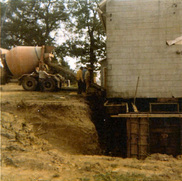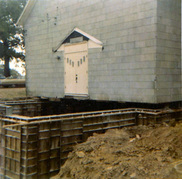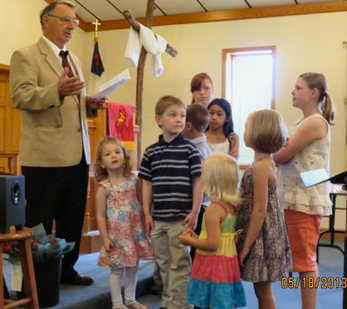A Brief History of New Hope UMC
This is a brief version of a more detailed history of the New Hope United Methodist Church, which was written by Kevin Smith in 2014. We have omitted some details which casual readers might be less interested in, while still highlighting significant events in the history of New Hope church.
The Beginning: 1879 - 1881
 Original bell now on a stand near our parking lot
Original bell now on a stand near our parking lot
In March of 1876 George M. Cottingham and his wife Sarah and their family
moved to a farm north of Clark Missouri. By August of 1879 the
community came together to hold brush arbor meetings on the farm. (In
those days it was common to create an open-air meeting space shaded from
the sun by cutting and stacking saplings; hence the name "brush
arbor".) This first brush arbor revival
began with three services daily and lasted about two weeks, with
preaching provided by pastors from both the Sturgeon and Clark areas.
Not long after, came the decision to construct a permanent church building. It was to be built as a Methodist church but was to be used by other denominations as well. The Baptists used it for several years, for instance. George Cottingham donated the land, and other community members donated materials--timber was sawn into lumber free of charge by local sawmills--as well as labor. The only hired labor was for a head carpenter to oversee the project. The total cash outlay to build that first New Hope church was $800.
Sarah Cottingham was given the privilege of naming the church because she had boarded the workers free of charge during construction. She chose the name "New Hope" and as being symbolic of what the church would mean to succeeding generations. The church was dedicated in June of 1881 at services led by the Rev. Robert White.
Not long after, came the decision to construct a permanent church building. It was to be built as a Methodist church but was to be used by other denominations as well. The Baptists used it for several years, for instance. George Cottingham donated the land, and other community members donated materials--timber was sawn into lumber free of charge by local sawmills--as well as labor. The only hired labor was for a head carpenter to oversee the project. The total cash outlay to build that first New Hope church was $800.
Sarah Cottingham was given the privilege of naming the church because she had boarded the workers free of charge during construction. She chose the name "New Hope" and as being symbolic of what the church would mean to succeeding generations. The church was dedicated in June of 1881 at services led by the Rev. Robert White.
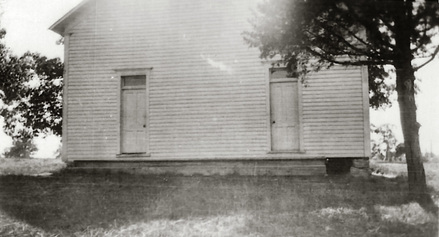
That first New Hope church was built on the exact spot where New Hope UMC stands today. Interestingly, it was built with two separate doors on the front, one for women to enter and one for men, as was typical of churches in that day.
Early Years, 1880s - 1920s
|
Like many rural churches of its day, Sunday services were usually led by a pastor only once a month
at New Hope. The pastors who served here one Sunday a month also served
other churches in the area, where they preached on the other Sundays.
With the pastor present usually only one Sunday a month, a rich Sunday School tradition flourished.
When most of us think of Sunday school today we think of adults and children heading off to their Sunday school classes. But it began as much more. Since the preacher was not there the congregation held their own worship service, assembling for prayer, hymns, announcements, a Scripture reading, and often a brief message from the Sunday School Superintendent or a lay speaker, before splitting up into Sunday School classes. Back then the church building consisted of just one large sanctuary room, so Sunday School classes simply met in different corners of the sanctuary. |
|
The tradition of having the congregation assemble before going to Sunday School classes is still practiced in some United Methodist churches, even in congregations where a pastor delivers a sermon every Sunday. At New Hope we departed from that tradition around 2005, so that the time used for gathering the congregation briefly before Sunday School could instead be used for Sunday School classes. (We had already gathered once for the worship service; to gathering a second time before Sunday School seemed less useful than it once had, given that few people now were coming just for Sunday School alone.)
|
Middle Years, 1930s - 1960s
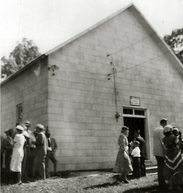
The first women's Missionary Society was organized at New Hope in the 1930s. Its name was changed to Women's Society of Christian Service in the 1940s, then changed again to United Methodist Women in the 1970s--the name still used for the group today. Over the years this group has been driving force behind many activities at New Hope, particularly in raising funds for community and worldwide missions, as well as local church needs. Auctions were held for many years, but in 1975 they were replaced with an annual chili-soup supper and bazaar.
In 1953 a large room was added to the back of the church at a cost of about $3000. This added three Sunday School rooms and also doubled as a kitchen and banquet room. For the first time, Sunday School classes did not all have to meet in the one-room sanctuary. A second altar area was most likely built around this time, along with constructing a single entrance instead of the two front doors with which the 1881 church had been built.
In 1953 a large room was added to the back of the church at a cost of about $3000. This added three Sunday School rooms and also doubled as a kitchen and banquet room. For the first time, Sunday School classes did not all have to meet in the one-room sanctuary. A second altar area was most likely built around this time, along with constructing a single entrance instead of the two front doors with which the 1881 church had been built.
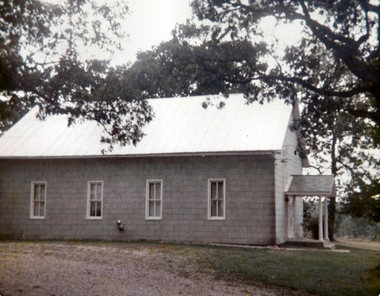
These were years of large, vibrant congregations throughout the United States, and things were that way here at New Hope. Worship services began being held on the first and third Sundays of each month instead of just once a month. (The pastor was still shared with other churches, where preached on the alternate Sundays.) Sunday School attendance was often even larger than that of the worship service. Events like the church's Thanksgiving meal packed the building with members from New Hope and the surrounding community alike. The youth group was large and active.
Soon to alter the landscape, in 1954 an Amish community began to the east and southeast of the church, and it would later grow to the northeast as well. Gradually as Amish families replaced non-Amish families those areas no longer were a source of members and support for New Hope. This change signaled a time of transition in which New Hope. The church that was built beside a dirt road in 1881 now found itself at the intersection of two blacktop highways, NN and P, and began to draw people from beyond the immediate communities of Clark and Renick, to include Higbee, Middle Grove, Harrisburg, Madison, and Moberly.
Soon to alter the landscape, in 1954 an Amish community began to the east and southeast of the church, and it would later grow to the northeast as well. Gradually as Amish families replaced non-Amish families those areas no longer were a source of members and support for New Hope. This change signaled a time of transition in which New Hope. The church that was built beside a dirt road in 1881 now found itself at the intersection of two blacktop highways, NN and P, and began to draw people from beyond the immediate communities of Clark and Renick, to include Higbee, Middle Grove, Harrisburg, Madison, and Moberly.
Reversing a Decline: 1970s - 1996
In 1970 Rev. Oscar Grindheim was assigned as New Hope's pastor. Before he could serve, he died after a sudden and brief illness. His wife, Rose, took over his pastoral assignment and would later go on to become ordained. (Rose Grindheim was a pastor of note, who would later revitalize several churches, author books, and start a large church in Florida. She was also the first of three women pastors to serve the congregation before the year 2000.)
When the Grindheims had arrived both the building and the congregation were in decline. The building sat on a foundation of limestone rocks; many areas had settled and were touching bare earth. An aging congregation and meager incomes had contributed to the lack of upkeep. The average age of the congregation had increased as the many youth of earlier years had grown up and moved on to other locations. Also, the Amish settlement's grows had continued to limit the potential for new members from the surrounding area. To all the buildings decline, a new basement was proposed.
|
"In the fall of 1972 with the prodding encouragement of New Hope's only pastor, Dr. Rose Fisher, the church began an ambitious program of remodeling which was completed debt-free less than two years later at an estimated cost of nearly $30,000 in donated labor, materials, and actual cash. Bill Orton Construction provided much labor and machinery. The altar area was rebuilt and carpeted, and the church interior and south Sunday School rooms were completely redecorated. An entrance or lobby with two more bathrooms were also added. The church basement has two small Sunday School rooms and a large area that doubles as Sunday School room, reception hall, and meeting place; there is a fully equipped kitchen and bathroom."
[A vaulted ceiling was also added to the sanctuary during this renovation.] |
During this time attendance grew, with the membership of 70 and at average Sunday School attendance of around 60. The area from which people were Being drawn to New Hoped was expanding. The youth group was reformed and active, and many activities were added which engaged and retained new individuals in the congregation. A youth scholarship program was begun in 1981, which would also reach out to others in the community. Together, a modern facility, active programming, and the leadership and pastoral skills of Dr. Rose Grindheim-Fisher (later Sims) produced a period of growth for New Hope.
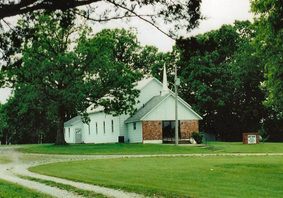
After Dr. Sims left, the church began sharing pastors with Huntsville UMC and later with West Park UMC in Moberly. Youth in the congregation began to drift away as they started their adult lives--they went to college, started jobs, and got married. And Dr. Sims strong draw was gone. The church began a significant decline, and by the mid-1980s average attendance was near 20.
Rev. Mark Harvey was pastor from 1986 - 1991. During this time the decline was halted and a modest rebound was seen. It was during this time that Rev. Harvey began holding worship services every Sunday--the format of having worship only on the first and third Sundays of the month was left behind. After his time here, Rev. Harvey went on to the St. Louis area where he would work on many social issues and causes.
Rev. Mark Harvey was pastor from 1986 - 1991. During this time the decline was halted and a modest rebound was seen. It was during this time that Rev. Harvey began holding worship services every Sunday--the format of having worship only on the first and third Sundays of the month was left behind. After his time here, Rev. Harvey went on to the St. Louis area where he would work on many social issues and causes.
A New Direction (for the sanctuary!), 1997 - 1998
|
By
1992 when our second female pastor, the Rev. Carol Koenig, was assigned
to New Hope, the building was again in general decline. Physical
problems with the basement--which had started soon after it was
built--began to add up. The aging congregation was using the basement
fellowship hall less and less, and programming and activities were
declining as well.
By 1997, under the leadership and direction of Rev. Koenig, the congregation sought a new vision for what New Hope could be. With Kevin Smith as chairman of the trustees a committee was formed, and the general discussion revolved around the facility's bad state of repair, how to address those issues, and how to make the facility more accessible. |
|
"Our completed project (phase 1) included moving the front entry to ground level on the East side (from the North), installing two new additional emergency exits, reversing the direction of the chapel (to make the flow of traffic better), turning the former entryway into a classroom, moving the kitchen upstairs, installing an accessible restroom, installing new sheet rock, windows and doors, installing carpeting throughout, installing extra lighting in the chapel and discontinuing the use of the basement (except for utilities) and reconditioning the floor and its support in the main chapel. The next phase includes a new roof, new siding, additional insulation, new sidewalks and ramps, and landscaping. This project was undertaken with safety, accessibility, and convenience concerns in mind (as well as making New Hope inviting). Our hope is to have a facility that is not only easy to use but that is indeed used by our church family and community."
[The renovation was completed in 1998.] |
A Tornado...and Opportunity: 1999 - 2000
|
In 1999, less than a year after the completion of the renovation, a tornado uprooted a tree at the south end of the church. It damaged the back of the recently renovated 1953 addition (Sunday School rooms/kitchen/fellowship hall). The congregation was growing and had outgrown the limited space of the fellowship hall, so the damage became an opportunity to triple the size of the fellowship hall plus add a utility room and an additional classroom. The additional space in our fellowship hall allowed New Hope to begin hosting Read Cross blood drives, four times a year.
Also during this time better lighting and an improved sound system were added. Stained-glass inserts were installed in the windows, more landscaping was added, and the parking lot and drives were paved. Rev. Koenig was followed by Rev. Phyllis Anderson, our third female pastor, who worked at cultivating our youth programs. |
A Pastor(s) of Our Own! 2001 - Present
In June of 2001 the church was assigned its own pastor, the Rev. Jesse Hood. Rev. Hood was a retired pastor and "officially" part-time, but he served the congregation as a full-time pastor. With the pastor of our own, New Hope was no longer part of a multi-church pastoral charge! Rev. Hood was here for 10 years (and had also served the church years before, for a single year), and during his time here the congregation and activities of the church continued to grow, and facilities continued to be maintained and improved.
Cathy Turner became our youth leader, and led the effort to expand youth programs, activities, and mission work. In 2002, with congregational support, the once-abandoned basement was renovated, making a bright, cheerful, comfortable area for our youth--a "youth center"--which is also now been used for expanded Sunday School classroom space.
Cathy Turner became our youth leader, and led the effort to expand youth programs, activities, and mission work. In 2002, with congregational support, the once-abandoned basement was renovated, making a bright, cheerful, comfortable area for our youth--a "youth center"--which is also now been used for expanded Sunday School classroom space.
|
Rev. Hood was succeeded by another retired pastor, Rev. Dick Curry (pictured at left). Also "officially part-time", Rev. Curry actually served New Hope full time, like his predecessor. As a pastor, a former assistant to the Bishop of the Missouri Conference of the United Methodist Church, and before that a mathematics instructor at the university level, Rev. Curry brought unique experience to his position.
Building on the growth Rev. Curry began, New Hope participated in the Small Church Initiative (SCI) in 2012. The SCI is a special program involving interviews of the congregation and church leaders, analysis by an outside consultant, training, and other facets, with the purpose being to evaluate strengths and weaknesses of the church and recommend changes to strengthen and grow the church. Rev. Curry re-retired (for good this time, he says!) in June of 2015, and the pastoral reins were picked up by Rev. Mike Will, a man of considerable and varied pastoral experience in the United Methodist church--including campus ministry to students at the U. of Missouri-Columbia. Where to from here? All we know for sure is that good things are yet to come for New Hope United Methodist Church. |
### END ###

